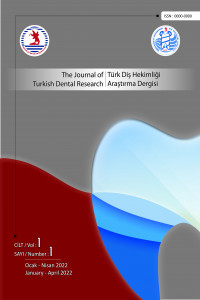Lingual ve Labial Sabit Ortodontik Aygıtların Etkilerinin Karşılaştırılması: Retrospektif Çalışma
Lingual ortodonti, Labial ortodonti, Anket, Karşılaştırma
Comparison the Effects of Lingual and Labial Fixed Orthodontic Appliances: A Retrospective Study
Lingual ortodonti, Labial ortodonti, Anket, Karşılaştırma,
___
- 1. Behnaz M, Farahnaki A, Rahimipour K, Mousavi R, Davoodi NS. Lingual Orthodontic Treatment: Efficacy and Complications. J Advanced Oral Res. 2019;10(2):65-74.
- 2. Rosvall MD, Fields HW, Ziuchkovski J, Rosenstiel SF, Johnston WM. Attractiveness, acceptability, and value of orthodontic appliances. Am J Orthod Dentofac Orthop. 2009;135(3):276. e1-. e12.
- 3. Amasyali M, Uysal T. Lingual ortodonti. Cumhuriyet Dent J. 2009;12(1):67-77.
- 4. Favale ML, Fusco R, Lesti M, Horodynski M, Toni B. Lingual vs. Labial fixed orthodontic appliances: comparison of adverse effects. WebmedCentralcom. 2017:5 pages.
- 5. Haj-Younis S, Khattab TZ, Hajeer MY, Farah H. A comparison between two lingual orthodontic brackets in terms of speech performance and patients’ acceptance in correcting Class II, Division 1 malocclusion: a randomized controlled trial. Dental Press J Orthod. 2016;21(4):80-8.
- 6. Hohoff A, Seifert E, Fillion D, Stamm T, Heinecke A, Ehmer U. Speech performance in lingual orthodontic patients measured by sonagraphy and auditive analysis. Am J Orthod Dentofac Orthop. 2003;123(2):146-52.
- 7. Nassif CE, Cotrim-Ferreira A, Conti ACCF, Valarelli DP, de Almeida Cardoso M, de Almeida-Pedrin RR. Comparative study of root resorption of maxillary incisors in patients treated with lingual and buccal orthodontics. Angle Orthod. 2017;87(6):795-800.
- 8. Deguchi T, Terao F, Aonuma T, Kataoka T, Sugawara Y, Yamashiro T, et al. Outcome assessment of lingual and labial appliances compared with cephalometric analysis, peer assessment rating, and objective grading system in Angle Class II extraction cases. Angle Orthod. 2015;85(3):400-7.
- 9. Papageorgiou SN, Gölz L, Jäger A, Eliades T, Bourauel C. Lingual vs. labial fixed orthodontic appliances: systematic review and meta‐analysis of treatment effects. Eur J Oral Sci. 2016;124(2):105-18.
- 10. Cline ME, Herman J, Shaw ER, Morton RD. Standardization of the visual analogue scale. Nursing Res. 1992;41(6):378-80.
- 11. Abdulmajed, A. Erişkin hastalarda direkt lingual ve labiyal ortodontik tedavi etkilerinin, hasta konforunun ve memnuniyetinin karşılaştırılarak incelenmesi. Doktora tezi, Hacettepe Üniversitesi, Ankara 2010.
- 12. Yeşil Şahin, E. İndirekt lingual ortodonti ve şeffaf plak teknikleriyle yapılan ortodontik tedavilerde hasta konforu, memnuniyeti, tedavi etkileri ve tedavi süresinin karşılaştırılması. Doktora tezi, Hacettepe Üniversitesi, Ankara 2015.
- 13. Feu D, de Oliveira BH, de Oliveira Almeida MA, Kiyak HA, Miguel JAM. Oral health-related quality of life and orthodontic treatment seeking. Am J Orthod Dentofac Orthop. 2010;138(2):152-9.
- 14. Hardwick LJ, Sayers MS, Newton JT. Patient’s expectations of lingual orthodontic treatment: a qualitative study. J Orthod. 2017;44(1):21-7.
- 15. Chow J, Cioffi I. Pain and orthodontic patient compliance: a clinical perspective. Seminars in Orthod. 2018;24(2):242-7.
- 16. Billaiya P, Amin V, Begum M. Assessment of efficacy (Time taken during stage I and pain perception) of customized lingual orthodontic system. Int J App Dent Sci. 2019;5(3):234-9.
- 17. Tecco S, D’Attilio M, Tetè S, Festa F. Prevalence and type of pain during conventional and self-ligating orthodontic reatment. Eur J Orthod. 2009;31(4):380-4.
- 18. Wu AK, McGrath C, Wong RW, Wiechmann D, M. Rabie AB. A comparison of pain experienced by patients treated with labial and lingual orthodontic appliances. Eur J Orthod. 2010;32(4):403-7.
- 19. Rai AK, Rozario JE, Ganeshkar SV. Comparison of speech performance in labial and lingual orthodontic patients: A prospective study. Dent Res J. 2014;11(6):663-75.
- 20. Khattab TZ, Farah H, Al-Sabbagh R, Hajeer MY, Haj-Hamed Y. Speech performance and oral impairments with lingual and labial orthodontic appliances in the first stage of fixed treatment: a randomized controlled trial. Angle Orthod. 2013;83(3):519-26.
- 21. Caniklioglu C, Öztürk Y. Patient discomfort: a comparison between lingual and labial fixed appliances. Angle Orthod. 2005;75(1):86-91.
- 22. Shalish M, Cooper-Kazaz R, Ivgi I, Canetti L, Tsur B, Bachar E, et al. Adult patients’ adjustability to orthodontic appliances. Part I: a comparison between Labial, Lingual, and Invisalign™. Eur J Orthod. 2012;34(6):724-30.
- 23. Rakhshan H, Rakhshan V. Pain and discomfort perceived during the initial stage of active fixed orthodontic treatment. Saudi Dent J. 2015;27(2):81-7.
- 24. Ali SJ, Sasanka LK, Ramanadhan V, Ganapathy D. Orthodontics and Smile Correction in Teenagers-A Survey. Indian J Forensic Med & Tox. 2020;14(4):5486-93.
- 25. Lee R, Hwang S, Lim H, Cha J-Y, Kim K-H, Chung CJ. Treatment satisfaction and its influencing factors among adult orthodontic patients. Am J Orthod Dentofac Orthop. 2018;153(6):808-17.
- 26. Wu A, McGrath C, Wong R. W. K., Wiechmann D., and Rabie A. B. M. Comparison of oral impacts experienced by patients treated with labial or customized lingual fixed orthodontic appliances. Am J Orthod Dentofac Orthop. 2011;139(6):784-90.
- Başlangıç: 2022
- Yayıncı: Ondokuz Mayıs Üniversitesi
Mustafa ŞİMŞEKYILMAZ, Taner ARABACI, Elif BİLİCİ, Beyza Nur ŞAHİN
Lingual ve Labial Sabit Ortodontik Aygıtların Etkilerinin Karşılaştırılması: Retrospektif Çalışma
Nurhat ÖZKALAYCI, Orhan ÇİÇEK, Yunus OCAK
Dijital Tam Protezlerin Üretiminde Kullanılan Sistemler
Çağla Nur GEDİKLİ, Tayfun BİLGİN
Meryem KAYGISIZ YİĞİT, Rıdvan AKYOL, Beyza YALVAÇ, Fatma DİLEK, Emin Murat CANGER
